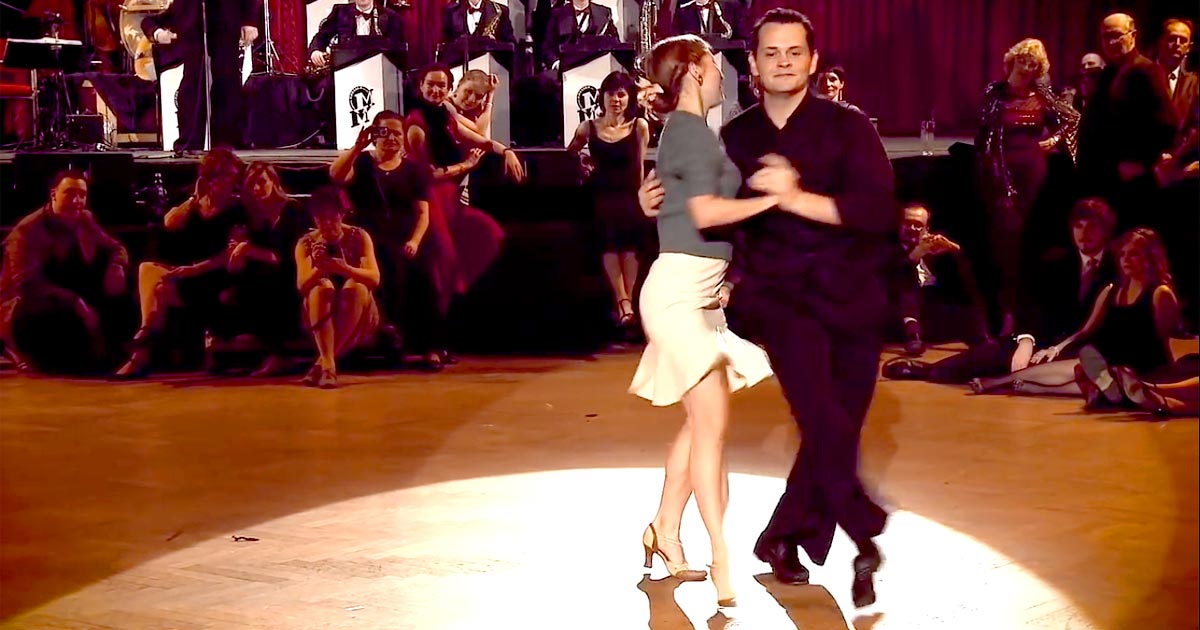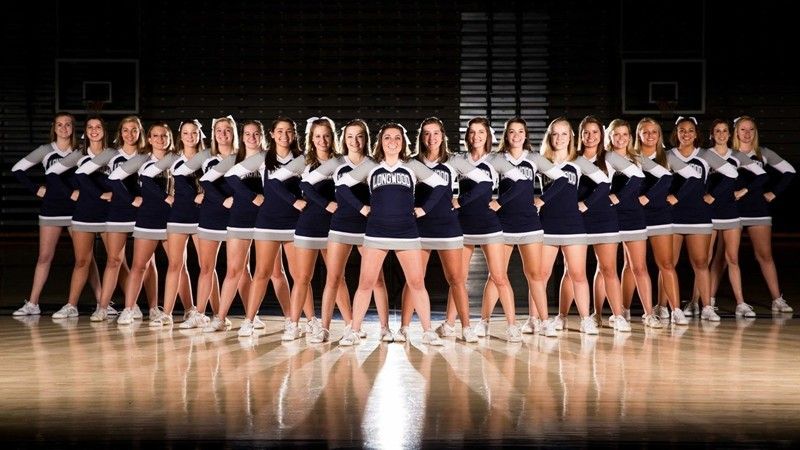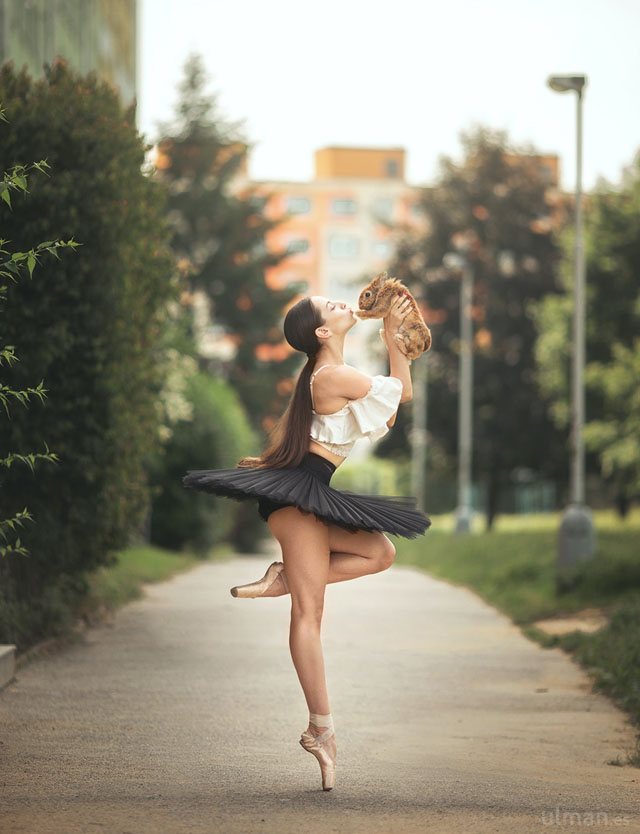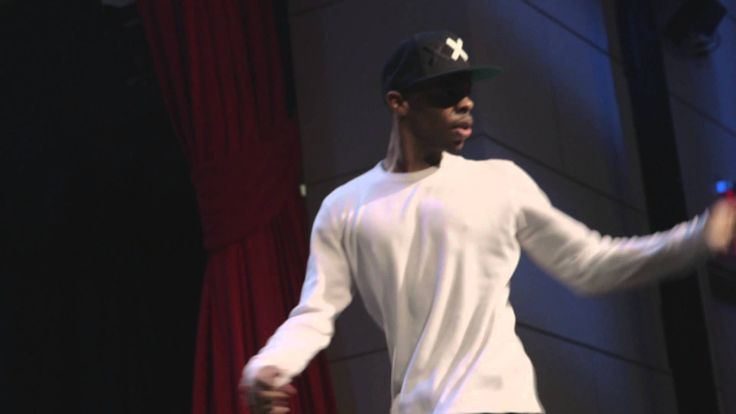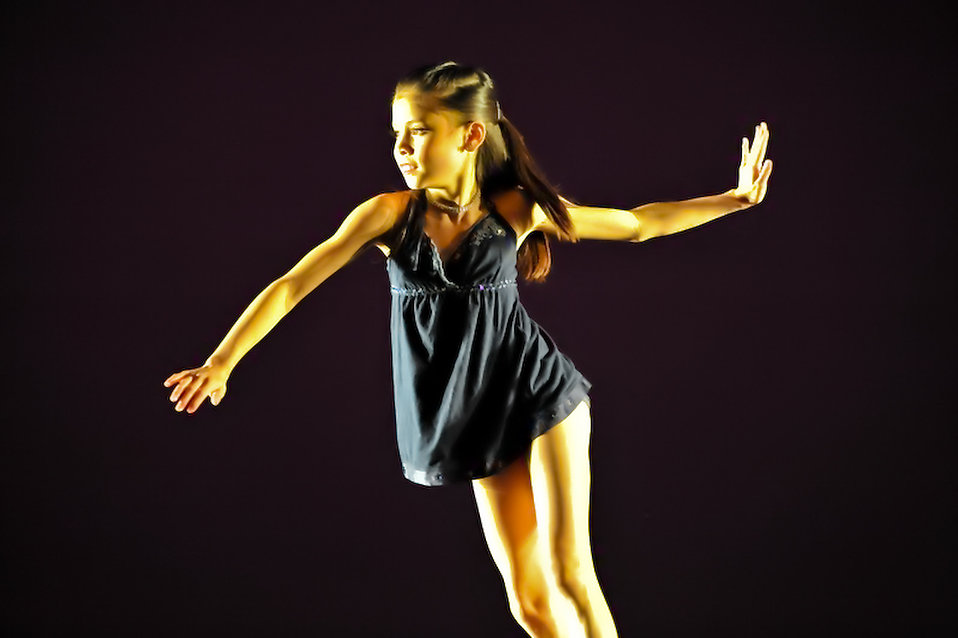How to dance the quadrille
Cotillon Steps and Quadrille Steps
The Cotillon
A few years ago, I wrote a series of posts about the cotillon steps recorded by London’s dancing masters in the 1760s. In 1762, De la Cuisse (who began the cotillon craze by publishing these dances) listed six steps in his Le Repertoire des bals ou theorie-pratique des contredanses – balancé, rigaudon, contretems, chassé, pirouette and pas de gavotte (the demi-contretems, which he described as ‘un Pas naturel; C’es le Pas fondamental de la Contredanse’). All are familiar from the dance manuals of the early 1700s. Between them, Gallini, Gherardi and Villeneuve added another six – assemblé, glissade, ‘brizè à trois pas’, ‘chassé à trois pas’, double chassé and sissonne. Three of these were also described in the earlier manuals, while three – the brizé and chassé ‘a trois pas’ and the double chassé were apparently more recent.
The Quadrille
The step vocabulary for the early 19th-century quadrille was more extensive and some of the steps were certainly more challenging than any used in the cotillon. One of the earliest works to deal with the quadrille was Notions élémentaires sur l’art de la danse by J. H. Gourdoux-Daux, published in Paris in 1804. The second edition was titled Principes et notions élémentaires sur l’art de la danse pour la ville and appeared in 1811. It was presumably this edition that was translated into English for publication in Philadelphia in 1817 as Elements and Principles of the Art of Dancing as used in Polite and Fashionable Circles. This translation describes nine steps for use in quadrilles – the ‘change of foot’ (changement de jambe), assemblé, jeté, sissonne, échappé, temps levé, grand coupé, chassé and glissade. Only one, chassé, is among the cotillon steps prescribed by De la Cuisse, while three more appear in the collections published in London – assemblé, glissade and sissonne. The last of these occurs only in Villeneuve’s Collection of Cotillons and he does not describe it. By the time Gourdoux-Daux was writing, the sissonne had become a spring from two feet to one, beginning in third position and ending with the free foot either extended to second or fourth position or brought into the ankle. It is recognisable as the second part of the pas de sissonne recorded in the early 1700s.
Only one, chassé, is among the cotillon steps prescribed by De la Cuisse, while three more appear in the collections published in London – assemblé, glissade and sissonne. The last of these occurs only in Villeneuve’s Collection of Cotillons and he does not describe it. By the time Gourdoux-Daux was writing, the sissonne had become a spring from two feet to one, beginning in third position and ending with the free foot either extended to second or fourth position or brought into the ankle. It is recognisable as the second part of the pas de sissonne recorded in the early 1700s.
Gourdoux-Daux published a third edition of his treatise titled simply De l’art de la danse in 1823, which is accessible digitally. It adds a tems du balonné, pas de bourrée, tems de cuisse, demi-contretems, brisé and entrechat. His third edition is described as ‘revue, corrigé et augmenté’, indicating that it contains new material. However, without access to Gourdoux-Daux’s earlier editions, it is not possible to know whether he included any of these steps before 1823 or whether his American translator simply omitted them as either not generally used or, perhaps, not appropriate for social dancing.
However, without access to Gourdoux-Daux’s earlier editions, it is not possible to know whether he included any of these steps before 1823 or whether his American translator simply omitted them as either not generally used or, perhaps, not appropriate for social dancing.
In 1822, Alexander Strathy published his Elements of the Art of Dancing in Edinburgh. His list has twelve quadrille steps – assemblé, jeté, glissade, sissonne, temps levé, chassé, échappé, pirouette, changement de jambe, pas de Zéphyre or pas battu, jeté tendu and jeté du côté. His vocabulary overlaps with that of Gourdoux-Daux, but both have steps not included by the other.
The only other treatise I will look at here is Charles Mason’s A Short Essay on the French Danse de Société published in London in 1827. His vocabulary overlaps with both Gourdoux-Daux and Strathy and also includes steps they do not list.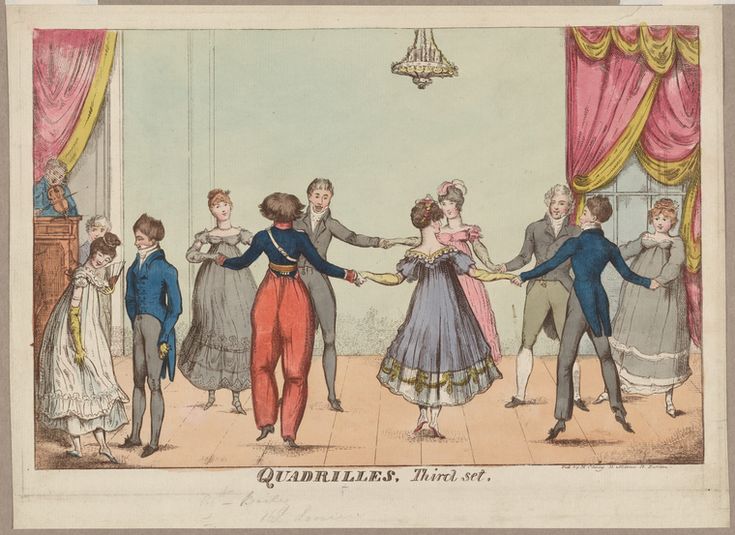 Mason’s list has twenty of what he calls ‘Les Mouvemens’ – changement de jambes, assemblé, jeté, sissonne, tems levé, chassé, glissade, jeté ballonné, tems de Zéphyre, coupé, pas de basque, pas de bourrée, tems de ‘coudepied’, jeté brisé, pas tombé, fouetté, contretems, pirouette, emboîté and petits battemens. Some of these may have been embellishments to steps, rather than steps in their own right, and some may have been used only within the ‘Differens Enchainemens de Pas’ Mason refers to on his title page.
Mason’s list has twenty of what he calls ‘Les Mouvemens’ – changement de jambes, assemblé, jeté, sissonne, tems levé, chassé, glissade, jeté ballonné, tems de Zéphyre, coupé, pas de basque, pas de bourrée, tems de ‘coudepied’, jeté brisé, pas tombé, fouetté, contretems, pirouette, emboîté and petits battemens. Some of these may have been embellishments to steps, rather than steps in their own right, and some may have been used only within the ‘Differens Enchainemens de Pas’ Mason refers to on his title page.
In the following table I have tried to set out the steps recommended for the cotillon and quadrille respectively, with the name of each dancing master to include it listed in order of the date of their first publication in which it appears. For the purposes of this investigation, I have omitted the Allemande step used in so many cotillons – it is probably worth another post of its own (although I did write about it a few years ago). There were, of course, several other works on dancing – and the quadrille – published in the early decades of the 19th century, so my list of steps is probably far from complete and it is certainly not definitive. How and why did the step vocabulary change and expand so much as the cotillon gave way to the quadrille?
For the purposes of this investigation, I have omitted the Allemande step used in so many cotillons – it is probably worth another post of its own (although I did write about it a few years ago). There were, of course, several other works on dancing – and the quadrille – published in the early decades of the 19th century, so my list of steps is probably far from complete and it is certainly not definitive. How and why did the step vocabulary change and expand so much as the cotillon gave way to the quadrille?
Like this:
Like Loading...
Its Origins and History : Interlude
You might know the Quadrille as a dance from Alice in Wonderland. When she’s speaking with the Mock Turtle and the Gryphon, they tell her about the dance they used to perform at school, when they were learning the fundamentals of Reeling and Writhing and Drawling, Stretching, and Fainting in Coils. The Lobster Quadrille involved all the fish in the sea taking a lobster as a partner, and, at the last part of the dance, throwing them out to sea.
The people’s dance of the quadrille, as opposed to the Lobster Quadrille, was an early version of the American Square Dance. As can be determined from the name, the number ‘4’ was important to this dance. It started in the military, where 4 mounted horsemen would execute square formations. On the dance floor, the quadrille started in France around 1760. Two couples, and then eventually, four couples formed a square, and each couple danced in turn. The head couple would dance a step and the side couples would repeat it.
In 1816, the quadrille hit England, introduced from Paris by Lady Jersey, and it was an instant hit. In his book of reminiscences, the dandy Rees Howell Gronow (1794-1865) found it so memorable that he lists the dancers of the very first quadrille in England: ‘I recollect the persons who formed the very first quadrille that was ever danced at Almack’s: they were Lady Jersey, Lady Harriett Butler, Lady Susan Ryde, and Miss Montgomery; the men being the Count St.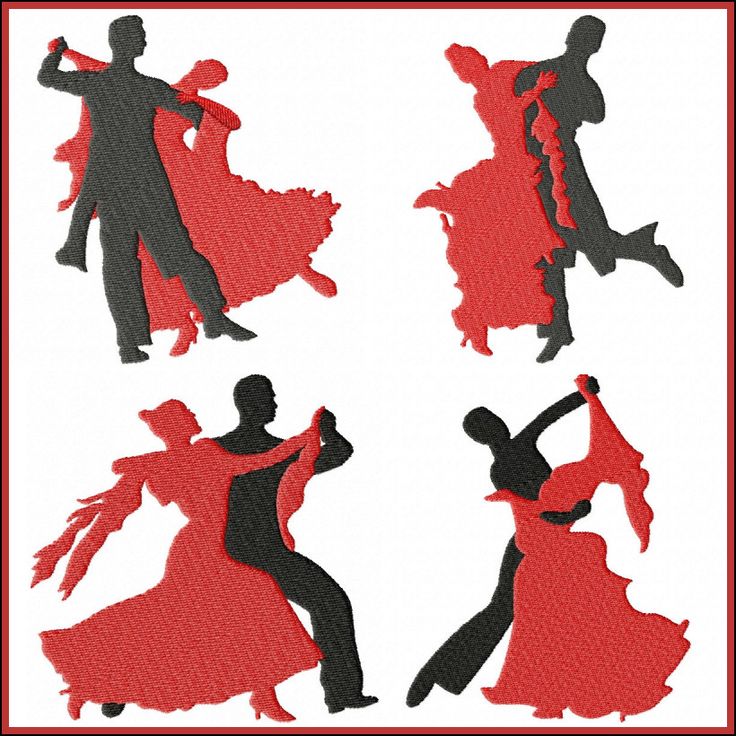 Aldegonde, Mr. Montgomery, Mr. Montague, and Charles Standish.’
Aldegonde, Mr. Montgomery, Mr. Montague, and Charles Standish.’
Joseph Grego: The First Quadrille at Almack’s, introduced by Lady Jersey, from The Reminiscences and Recollections of Captain Gronow, 1862
The quadrille was made up of a series of dances that were performed in sequence, called Le Pantalon (“Trousers”), L’été (“Summer”), La Poule (The Hen”), La Trénis (named for the dance master Trenitz), La Pastourelle (“The Shepherd Girl”), Finale. The music was a series of 8-measure themes, with each part of the sequence being in a different time, alternating between 2/4 and 6/8.
George Cruikshank: Dos à Dos / Accidents in Quadrille Dancing, 1817 (Minneapolis Institute of Art)
The dancing was complicated and the caricaturist George Cruikshank took advantage of the frequent accidents in his pictures from 1817, Dos à Dos and Vis à Vis (Back to Back and Face to Face).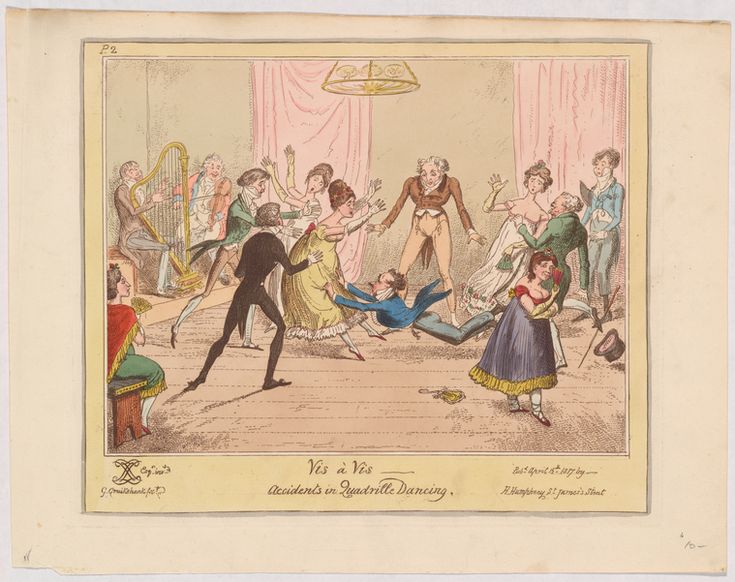
George Cruikshank: Vis à Vis / Accidents in Quadrille Dancing, 1817 (Minneapolis Institute of Art)
He also showed the beauty of the dance in full motion:
Moulinèt: Elegancies of Quadille Dancing, 1817 (Minneapolis Institute of Art)
The dance composers in Austria, Joseph Lanner and the Strauss dynasty quickly brought out quadrilles.
Johann Strauss I: Orpheus-Quadrille, Op. 162 (Slovak State Philharmonic Orchestra, Košice; Mika Eichenholz, cond.)
As you can hear, the Quadrille sounds like a series of short dances. As each couple danced out from the corners of the square, they would have a different dance and time signature with each new section.
Johann Strauss II / E. Strauss / Josef Strauss: Schutzen-Quadrille (Vienna Philharmonic Orchestra; Zubin Mehta, cond.)
As with all fashions, the quadrille would be sidelined by that even more controversial dance, the Waltz.
For more of the best in classical music, to our E-Newsletter
Circular quadrille
Pair dance for children 8-9 years old.
Dance is included in the Rhythm Program for the 2nd grades of St. Petersburg secondary schools.
Music:
Time signature 2/4.
Basic dance elements:
- Dance step
- Side steps
- Crossed steps
- Heel steps
- Exposing the foot to the side on the heel, or step-heel to the side
- "Do-for-do" (dos-à-dos - back to back)
- Stepping over
- Step-point (step-tap, or step-strike)
BRIEF DESCRIPTION OF THE DANCE
Dance recording - Kondratenko G.M. ("Dances and games for children of 6 years of age". Methodological development. Compiled by Kondratenko G.M. St. Petersburg, NOU "Institute for the Development of Education "Change", 2007.)
Dance editing - according to GMO seminars for ballroom dance and rhythm teachers at SPb GDTYu
Dance composition takes 16 measures of musical accompaniment
Starting position:
The dancers stand in pairs in a circle, facing each other: the boy is facing along the line of dance, the girl is standing with her back along the line of dance.
Feet in 1 (natural) position.
Hands raised to 2nd position, hands joined - "by fingers".
1 figure - Side steps to the center and from the center - 8 measures.
1-2 cycles. Count 1-2-3-4
The dancers perform side steps towards the center in pairs.
The boy starts with his left foot. The girl starts on the right foot.
1- Step from the toe to the side, towards the center (boy - left foot to the left, girl - right foot to the right).
2-Step back/cross - place the free leg back, about 3 pos. (boy - right leg, girl - left) and squat slightly on two legs.
3- One more step from the toe to the side, to the center (boy - left foot to the left, girl - right foot to the right).
4- Move the free leg to the side on the heel (the boy puts the right foot on the heel, the girl - the left). Don't lean on the outstretched leg. The supporting leg is slightly softened. The head turns towards the exposed leg (for the boy - to the right, for the girl - to the left). The movement is accompanied by a slight natural inclination of the body in the same direction.
The movement is accompanied by a slight natural inclination of the body in the same direction.
3-4 cycles. Count 5-6-7-8
Dancers in a pair repeat the movements of 1-2 measures, moving now from the center. The boy starts on the left foot, the girl on the right foot. Before the first step to the side, you need to remove the foot from the heel, pull the toe and take a step to the side from the toe.
5-8 strokes. Count 1-2-3-4, 5-6-7-8
Repeat movements 1-4 measures.
2 figure - "C-for-do" - 4 measures.
9-12 bars. Account 1-2-3-4-5-6-7-8
Partners separate their arms and lower them down along the body, the hands are raised.
Count 1-2-3-4-5-6-7- In 7 steps, the partners go around each other's backs, moving clockwise, and return to their places. The boy starts on the left foot, the girl on the right foot. Moving forward, partners meet with their right shoulders, moving backward - with their left.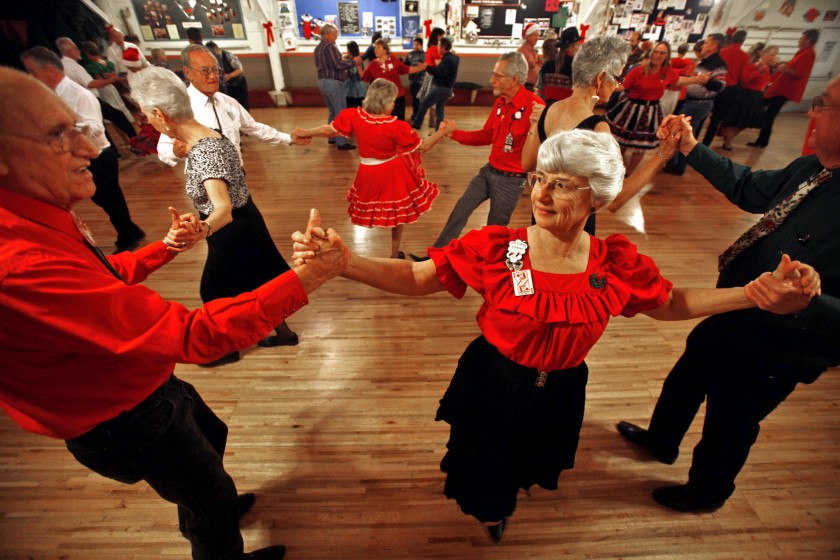 On the steps "to-for-do" the boy's hands move forward / backward along the body. The girl with each step makes a slight movement of her shoulders up / down.
On the steps "to-for-do" the boy's hands move forward / backward along the body. The girl with each step makes a slight movement of her shoulders up / down.
On a count of 8, place your free leg next to your skating leg. The boy puts his right leg without weight to his left leg. The girl puts her left foot to her right and transfers her weight to her left foot. (Both partners have their right leg free.)
3 figure - "Window" - 2 cycles.
13-14 bars.
Both dancers start with the right foot.
OPTION-1. Count 1-I-2, 3-I-4
1- Partners take a small step forward with their right foot (towards each other). The knee of the right leg softens. At the same time, they give each other their right hands and raise them in 3 poses. - "window". The left arms are lowered down, the hands are raised.
I-2- Partners step over in place (left foot, right foot), slightly tilting their heads to the left and looking at each other through the "window" from under the joined hands. Stepping is performed from the pad to the entire foot and is accompanied by springy movements in the knees up / down.
Stepping is performed from the pad to the entire foot and is accompanied by springy movements in the knees up / down.
3- Both partners take a small step back with their left foot (away from each other). The knee of the left leg softens. The connected right hands go down to level 1 pos.
I-4- Dancers perform a springy stepover in place (right foot, left foot).
OPTION-2. Count 1-2-3-4
Instead of stepping over, you can perform a tap with the free leg (soft ball kick) next to the supporting leg:
1-2- Small step with the right foot forward and warm with the left foot next to the right foot.
3-4- Take a small step back with the left foot and tap with the right foot next to the left foot.
On a step forward, partners may not join hands in 3 poses, but move their right hands to each other from top to bottom, connecting the hands with a handshake ("hello"). On a step back, the hands are separated.
4 figure - Transition to a new partner - 2 measures.
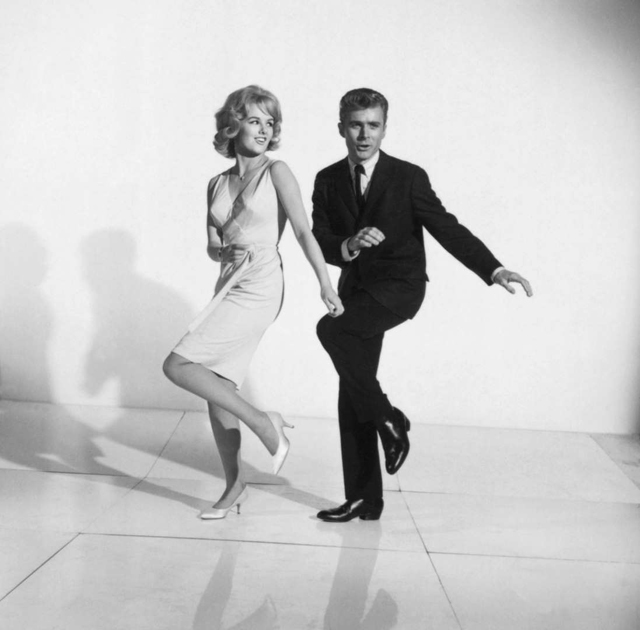
15-16 cycles. Score 5-6-7-8
Both the boy and the girl start with the right foot.
Count 5-6- Two steps forward with the right foot, passing each other and meeting with the right shoulders: the boy moves forward along the line of dance in the inner circle, the girl moves forward against the line of dance in the outer circle. The dancers move on to new partners. On the steps, the boy's hands move forward / backward along the body. The girl with each step makes a slight movement of her shoulders up / down.
Count 7-8- Take a step with the right foot to the side (in front of the new partner) and bring the left foot to the right in 1 pos. The boy puts his left foot to his right foot without weight. The girl, putting her left foot to her right, transfers the weight of the body to her. (The boy's left leg is free, the girl's right.) At the same time, the dancers join their hands in the starting position with a new partner.
The dance composition is repeated with a new partner.
Literature
- " Dances and games for children 6 years of age ". Methodological development. Compiled by Kondratenko G.M. St. Petersburg, NOU "Institute for the Development of Education" Change ", 2007
- Educational and methodological recommendations for organizing work with the whole class in elementary school on rhythm, rhythmoplasty and ballroom dancing . Shutikov Yu.N. St. Petersburg, 2006
- " Folk dances ". Series "Everybody dance". Author-compiler O.V. Ivannikov. Moscow - ed. AST, Donetsk - ed. STALKER, 2007
- " Rhythm at school, the third lesson of physical culture ". Teaching aid. Zh.E. Firileva, A.I. Ryabchikov, O.V. Zagryadskaya. Publishing House Phoenix, Rostov-on-Don, 2014
Poems for children about the dance "Circular quadrille "
For Russian quadrille, old
Only four pairs are needed.
And in the ROUND QUADRILL
Everyone will dance with you!
Video for the dance "Circular Quadrille"
Figures of the dance demonstrate KONDRATENKO G.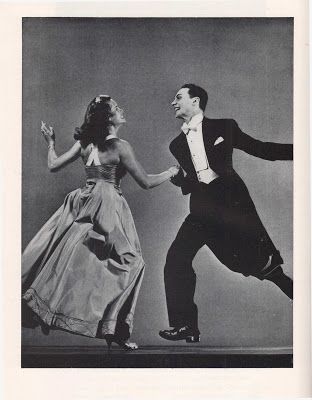 M. - Head of the GMO of ballroom dance teachers at St. Petersburg State Children's and Youth Theater and ZOLOTOVKHAYA T.V. - Lecturer in the choreography department of the Leningrad Regional College of Culture and Art. The recordings were made at seminars for ballroom dance teachers.
M. - Head of the GMO of ballroom dance teachers at St. Petersburg State Children's and Youth Theater and ZOLOTOVKHAYA T.V. - Lecturer in the choreography department of the Leningrad Regional College of Culture and Art. The recordings were made at seminars for ballroom dance teachers.
The full composition of the dance is presented on video recordings made at the GMO seminar for ballroom dance teachers at St. A.I. Herzen in ballroom dancing among students and youth and at the City competition of dance groups under the program "Rhythmika". This is a lively, fast dance. Varieties of square dances
Some dances of world culture, having acquired certain distinctive features, have become widespread not only in their homeland, but also beyond its borders. These include the square dance - a pair dance, which was once a salon and eventually spread among the people.
Certain changes have taken place today in the movements and in the manner of performance, but the main compositional features of this original historical dance have survived to this day.
History of dance
Few people know that quadrille is a French dance. But there is another version, according to which it originally arose at the end of the 17th century in England and had the name "country dance". This is a dance that originated among the peasantry. There is another opinion about the origin of the name. Its essence is that the performers are located opposite each other, and the word “contre” is translated from French as “against”. It became especially popular in the performance of several couples in France, and the name "quadrille" was given to it.
The dance became very popular over the decades and appeared in almost all European territory, including Russia, where it began to be widely spread in the 19th century. Finding itself in an unusual atmosphere, the French quadrille absorbed real Russian traditions. Some differences were also noted depending on the geography of distribution: in various regions, this magnificent dance was given movements that were characteristic only of local traditions.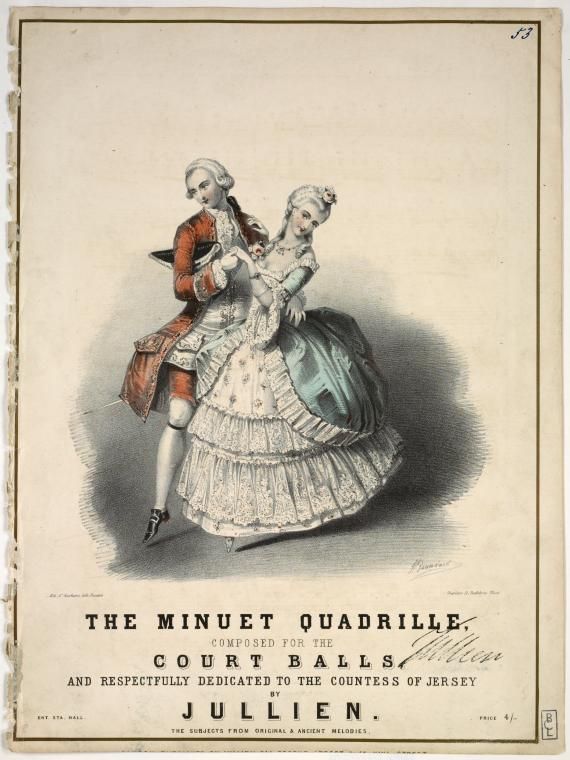 For example, in some regions, kisses are present during its performance.
For example, in some regions, kisses are present during its performance.
The quadrille is a dance that was performed even at the assemblies of Peter I at the beginning of the 18th century.
Having conquered the visitors of the higher salons and the spectators of the dance halls, the square dance quickly began to spread among the common people and turned into one of the favorite dances.
Old figures began to be processed, changed, and new ones began to appear. All these changes provided this truly folk dance with a long life.
The history of the origin of the name
The name of the dance "quadrille" clearly has common roots with the French "quadrille", with the Spanish "cuadrilla" and with the Latin "quadrum". In this regard, doubts arise about the country in which this dance originated.
Nevertheless, historical sources confirm the origin of the French, originally as a ballroom dance, formed from the English country dance. The latter was danced by peasants in England as early as the 17th century, and the quadrille itself had already spread to France, and then to other European countries in the 18th and 19th centuries.
Description
Quadrille is a lively, fast dance. Previously, couples were located opposite each other, in a quadrangle, and alternately performed their parts. Moreover, the dance consisted of five figures, which always ended with a common movement of all couples.
Despite the complexity of the figures, the movements were ideally practiced and brought to perfection by the salon dancers.
The quadrille has changed a lot over time, and the names of the movements, many of which have disappeared, have simply been replaced with numbers. Some movements have been simplified.
Types of square dance and their features
Folk square dance is a dance that has many varieties: Russian and Lithuanian, Ukrainian, Latvian, Estonian, Belarusian and even American. All of them are distinguished by diversity and originality.
There may also be local variations. For example, a Russian quadrille can be called Ural, Moscow and Volga.
Ukrainian quadrille is composed of many figures, reaching 12 in number.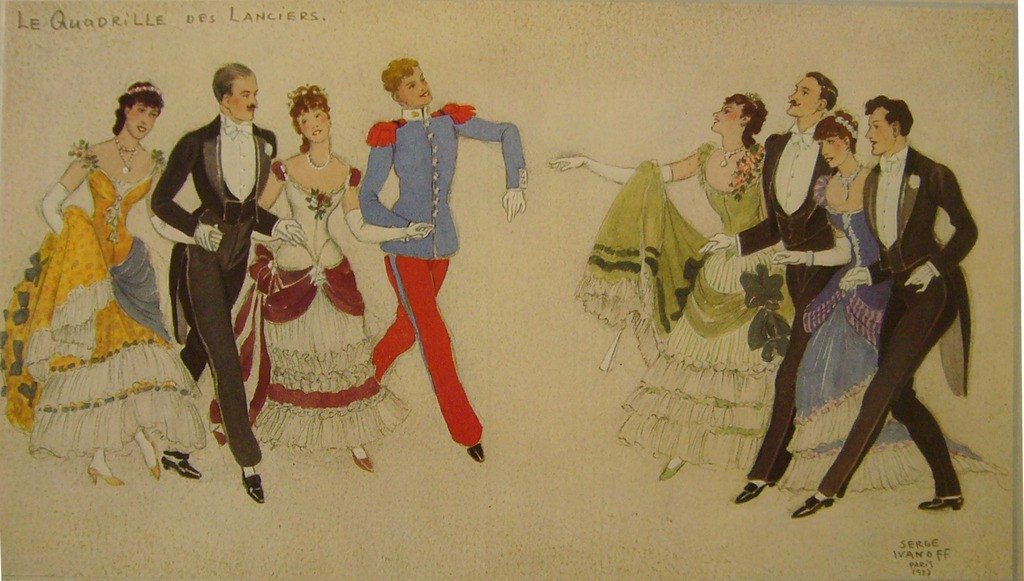
The Belarusian quadrille is a complex of simplicity with a variety of constructions. The total number of figures is from 4 to 12. A distinctive feature in the Belarusian quadrille is the inclusion of a solo, either separately or in pairs.
Russian version of quadrille
It should be noted that the genre of ditties that appeared later was quite closely intertwined with this cheerful dance. What does it look like? Performers during the dance can sing ditties in any order: all together, singly or in pairs. Often the quadrille is performed to many well-known songs.
Russian square dance is a dance that has a feature associated with an increase in the number of dancing couples and the fact that in some elements a dance appeared and each successive figure is separated from the previous movement by stopping the movement simultaneously with the music.
Russian quadrille presents the following three groups according to the form of its construction: angular or square, two-row or linear and circular.